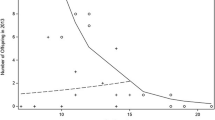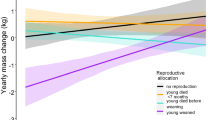Summary
Life history theory suggests that reproduction at one point in time involves costs in terms of energy, reduced survival, or probability of reproduction at a future point in time. ln long-lived iteroparous organisms, initiating reproduction at a relatively young age may exact a cost in terms of reduced survivorship, but an early age of first reproduction could be beneficial if it lengthens the breeding lifespan. Data collected over 30 years from one population of rhesus macaques, Macaca mulatta, were analyzed to determine the fertility and survivorship costs of initiating reproduction at a relatively young age. Low population density and high social status increased the chances of accelerating age at first parturition, but high dominance rank was not associated with greater lifetime reproductive success. Rapid reproductive maturation neither reduced short-term survivorship nor decreased lifespan. Fertility costs arose if young females reared a male, but not female, offspring. The fitness consequences of rapid reproductive maturation depend upon longevity, with age at death having a significantly greater impact on lifetime reproductive success than age at first parturition.
Similar content being viewed by others
References
Altman J, Hausfater G, Altmann SA (1988) Determinants of reproductive success in savannah baboons, Papio cynocephalus. In: Clutton-Brock TH (ed) Reproductive success. University of Chicago Press, Chicago, pp 403–418
Altmann SA (1962) A field study on the sociobiology of rhesus monkeys (Macaca mulatta). Ann NY Acad Sci 102:338–435
Bell G (1980) The costs of reproduction and their consequences. Am Nat 116:45–76
Berard JD (1990) Life history patterns of male rhesus macaques. PhD diss, University of Oregon
Bercovitch FB (1991) Social stratification, social strategies, and reproductive success in primates. Ethol Sociobiol 12:315–333
Bercovitch FB, Goy RW (1990) The socioendocrinology of reproductive development and reproductive success in macaques. In: Ziegler TE, Bercovitch FB (eds) Socioendocrinology of primate reproduction. Wiley-Liss, NY, pp 59–93
Berman CM (1988) Maternal condition and offspring sex ratio in a group of free-ranging rhesus monkeys: an eleven year study. Am Nat 131:307–328
Bryant DM (1979) Reproductive costs in the house martin (Delichon urbica). J Anim Ecol 48:655–675
Chapais B, Schulman SR (1980) An evolutionary model of female dominance relations in primates. J Theor Biol 82:47–89
Cheney CL, Seyfarth RM, Andelman SJ, Lee PC (1988) Reproductive success in vervet monkeys. In: Clutton-Brock TH (ed), Reproductive success. University of Chicago Press, Chicago, pp 384–402
Clutton-Brock TH (ed) (1988) Reproductive success. University of Chicago Press, Chicago
Clutton-Brock TH, Guinness FE, Albon SD (1982) Red deer: Behavior and ecology of two sexes. University of Chicago Press, Chicago
Clutton-Brock TH, Guinness FE, Albon SD (1983) The costs of reproduction to red deer hinds. J Anim Ecol 52:367–383
Datta S (1988) The acquisition of dominance among free-ranging rhesus monkey siblings. Anim Behav 36:754–772
De Steven D (1980) Clutch size, breeding success and parental survival in the tree swallow (Iridoprocne bicolor). Evolution 34:278–291
Drickamer LC (1974) A ten-year summary of reproductive data for free-ranging Macaca mulatta. Folia Primatol 21:61–80
Duggleby CR, Haseley PA, Rawlins RG, Kessler MJ (1986) An overview of blood group genetic studies on the Cayo Santiago rhesus monkeys. In: Rawlins RG, Kessler MJ (eds) The Cayo Santiago macaques. SUNY Press, Albany, pp 269–282
Ekman J, Askenmo C (1986) Reproductive cost, age-specific survival and a comparison of the reproductive strategy in two European tits (Genus Parus). Evolution 40:159–168
Endler JA (1986) Natural selection in the wild. Princeton University Press, Princeton
Falconer DS (1960) Introduction to quantitative genetics. Ronald Press, New York
Fedigan LM (1983) Dominance and reproductive success in primates. Yrbk Phys Anthropol 26:91–129
Fedigan LM, Fedigan L, Gouzoules S, Gouzoules H, Koyama N (1986) Lifetime reproductive success in female Japanese macaques. Folia Primatol 47:143–157
Gadgil M, Bossert WH (1970) Life historical consequences of natural selection. Am Nat 104:1–24
Green WCH, Berger J (1990) Maternal investment in sons and daughters: problems of methodology. Behav Ecol Sociobiol 27:99–102
Gustaffson L, Part T (1990) Acceleration of senescence in the collared flycatcher Ficedula albicollis by reproductive costs. Nature 347:279–281
Harcourt AH (1987) Dominance and fertility among female primates. J Zool 213:471–487
Harvey PH, Clutton-Brock TH (1985) Life history variation in primates. Evol 39:559–581
Harvey PH, Martin RD, Clutton-Brock TH (1987) Life histories in a comparative perspective. In: Smuts BB, Cheney DL, Seyfarth RM, Wrangham RW, Struhsaker TT (eds) Primate societies. University of Chicago Press, Chicago, pp 181–196
Horn HS, Rubenstien DI (1984) Behavioural adaptations and life history. In: Krebs JR, Davies NB (eds) Behavioral ecology: An evolutionary approach, 2nd edn. Sinauer, Sunderland, pp 279–298
Koyama N, Takahata Y, Huffman M, Norikoshi N, Suzuki H (1992) Reproductive parameters of female Japanese macaques: Thirty years data from the Arashiyama troops, Japan. Primates 33:33–47
Lee PC, Moss CJ (1986) Early maternal investment in male and female African elephant calves. Behav Ecol Sociobiol 18:353–361
Loy J (1988) Effects of supplementary feeding on maturation and fertility in primate groups. In: Fa J, Southwick CH (eds) Ecology and behavior of food-enhanced primate groups. Alan R. Liss, New York, pp 153–166
Luckinbill LS, Arking R, Clark MG, Cirocco WW, Buck SA (1984) Selection for delayed senescence in Drosophila melanogaster. Evolution 38:996–1003
MacArthur RH, Wilson EO (1967) The theory of island biogeography. Princeton University Press, Princeton
Marriott BM (1988) Time budgets of rhesus monkeys (Macaca mulatta) in a forest habitat in Nepal and on Cayo Santiago. In: Fa J, Southwick CH (eds) Ecology and behavior of food-enhanced primate groups. Alan R. Liss, New York, pp 125–149
Meikle DB, Vessey SH (1988) Maternal dominance rank and lifetime survivorship of male and female rhesus monkeys. Behav Ecol Sociobiol 22:379–383
Newton I (ed) (1989) Lifetime reproductive success in birds. Academic Press, San Diego
Nur N (1984) The consequences of brood size for breeding blue tits. I. Adult survival, weight change and the cost of reproduction. J Anim Ecol 53:479–496
Partridge L, Harvey PH (1988) The ecological context of life history evolution. Science 241:1449–1455
Paul A, Thommen D (1984) Timing of birth, female reproductive success and infant sex ratio in semifree-ranging Barbary macaques (Macaca sylvanus). Folia Primatol 42:2–16
Pianka ER (1978) Evolutionary ecology. Harper & Row, New York
Pianka ER, Parker WS (1975) Age-specific reproductive tactics. Am Nat 109:453–464
Rawlins RG, Kessler MJ (1985) Climate and seasonal reproduction in the Cayo Santiago macaques. Am J Primatol 9:87–99
Rawlins RG, Kessler MJ (1986a) The history of the Cayo Santiago colony. In: Rawlins RG, Kessler MJ (eds) The Cayo Santiago macaques. SUNY Press, Albany, pp 13–45
Rawlins RG, Kessler MJ (1986b) Demography of the free-ranging Cayo Santiago macaques (1976–1983). In: Rawlins RG, Kessler MJ (eds) The Cayo Santiago macaques. SUNY Press, Albany, pp 47–72
Reiter J, Le Boeuf BJ (1991) Life history consequences of variation in age at primiparity in northern elephant seals. Behav Ecol Sociobiol 28:153–160
Reznick D (1985) Costs of reproduction: an evaluation of the empirical evidence. Oikos 44:257–267
Roberts MS (1978) The annual reproductive cycle of captiva Macaca sylvanus. Folia Primatol 29:229–235
Rose MR (1984) Laboratory evolution of postponed senescence in Drosophila melanogaster. Evolution 38:1004–1010
Rose MR, Charlesworth B (1981a) Genetics of life-history in Drosophila melanogaster. I. Sib analysis of adult females. Genetics 97:173–186
Rose MR, Charlesworth B (1981b) Genetics of life-history in Drosophila melanogaster. II. Exploratory selection experiments. Genetics 97:187–196
Sade DS (1967) Determinants of dominance in a group of freeranging rhesus monkeys. In: Altmann SA (ed) Social communication among primates. University of Chicago Press, Chicago, pp 99–114
Sade DS (1991) Intrapopulation variation in life-history parameters. In: DeRosseau CJ (ed) Primate life history and evolution. Wiley-Liss, New York, pp 181–194
Sade DS, Chepko-Sade BD, Schneider JM, Roberts SS, Richtsmeier JT (1985) Basic demographic observations on free-ranging rhesus monkeys. Human Relations Area Files, New Haven (CT)
Simpson MIA, Simpson AE, Hooley J, Zunz M (1981) Infantrelated influences on birth intervals in rhesus monkeys. Nature 290:49–51
Smith JNM (1981) Does high fecundity reduce survival in song sparrows? Evolution 35:1142–1148
Sokal RR, Rohlf FJ (1981) Biometry, 2nd edn. WH Freeman, San Francisco
Soumah AG, Yokata N (1991) Female rank and feeding strategies in a free-ranging provisioned troop of Japanese macaques. Folia Primatol 57:191–200
Stearns SC (1976) Life history tactics: a review of the ideas. Q Rev Biol 51:3–47
Stearns SC (1977) The evolution of life-history traits. A critique of the theory and a review of the data. Annu Rev Ecol Syst 8:145–171
Sugiyama Y, Ohsawa H (1982) Population dynamics of Japanese monkeys with special reference to the effect of artificial feeding. Folia Primatol 39:238–263
Tuomi JT, Hakala T, Haukioja E (1983) Alternative concepts of reproductive efforts, costs of reproduction, and selection in life history evolution. Am Zool 23:25–34
Via S, Lande R (1985) Genotype-environment interaction and the evolution of phenotypic plasticity. Evolution 39:505–522
Williams GC (1966a) Adaptation and natural selection. Princeton University Press, Princeton
Williams GC (1966b) Natural selection, the costs of reproduction, and a refinement of Lack's principle. Am Nat 100:687–690
Wilson ME, Walker ML, Gordon TP (1983) Consequences of first pregnancy in rhesus monkeys. Am J Phys Anthropol 61:103–110
Wolff JO (1988) Maternal investment and sex ratio adjustment in American bison calves. Behav Ecol Sociobiol 23:127–133
Zar JH (1974) Biostatistical analysis. Prentice-Hall, Englewood Cliffs
Author information
Authors and Affiliations
Additional information
Correspondence to: F.B. Bercovitch
Rights and permissions
About this article
Cite this article
Bercovitch, F.B., Berard, J.D. Life history costs and consequences of rapid reproductive maturation in female rhesus macaques. Behav Ecol Sociobiol 32, 103–109 (1993). https://doi.org/10.1007/BF00164042
Received:
Accepted:
Issue Date:
DOI: https://doi.org/10.1007/BF00164042




